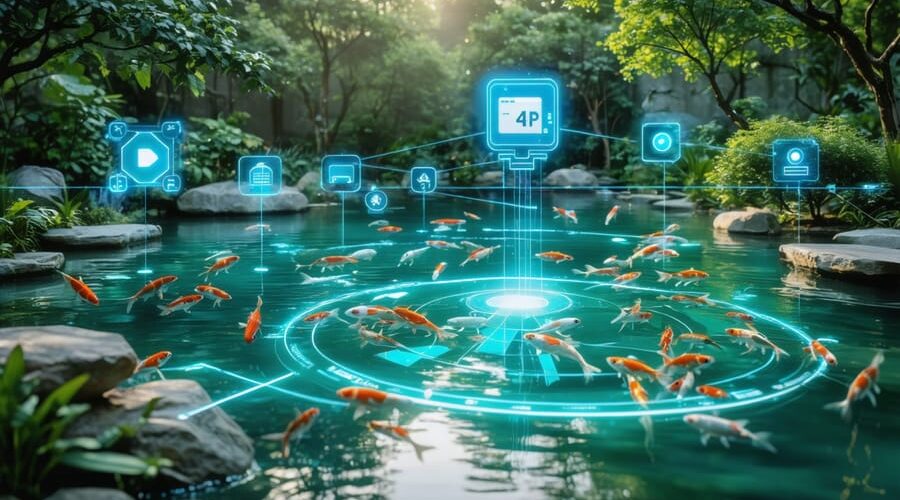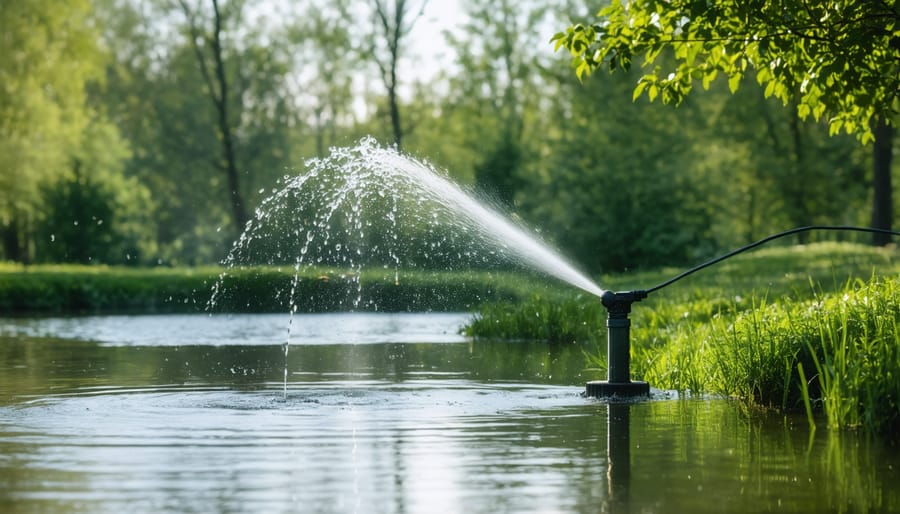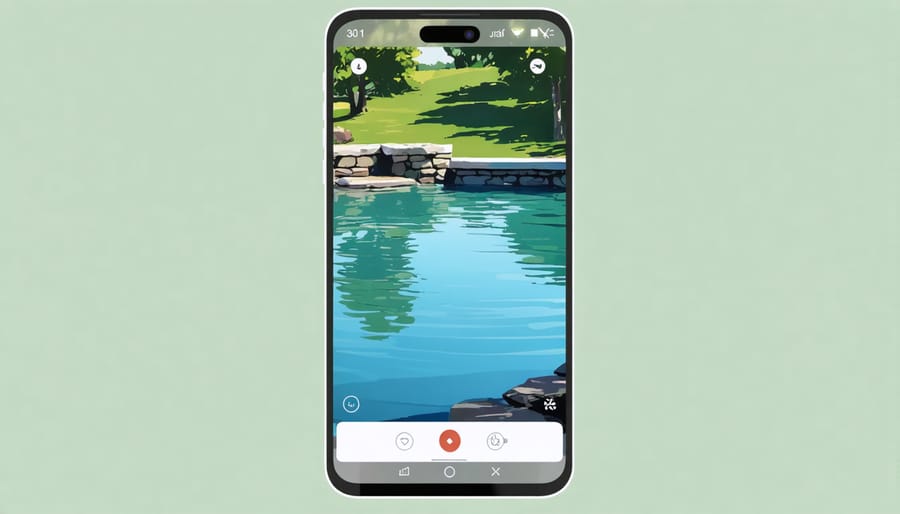
Smart Pond Protection: Modern Tech That Keeps Your Fish Safe
Protect your pond’s ecosystem with cutting-edge predator detection systems that instantly alert you to unwanted visitors. Modern pond management has evolved beyond simple netting and barriers, now incorporating sophisticated motion sensors, infrared cameras, and AI-powered monitoring solutions that work 24/7 to safeguard your aquatic investment.
Today’s predator defense technology combines traditional methods with smart innovations, creating multiple layers of protection for your fish and wildlife. Solar-powered deterrent lights flash at random intervals to startle herons and raccoons, while ultrasonic devices emit frequencies that keep unwanted visitors at bay without disturbing your fish. Underwater surveillance cameras stream real-time footage to your smartphone, allowing immediate response to potential threats.
For pond owners seeking peace of mind, these technological solutions offer unprecedented control and monitoring capabilities. Whether you’re protecting prize koi or maintaining a balanced ecosystem, modern predator management systems provide reliable, efficient protection while remaining surprisingly affordable and user-friendly. The key lies in choosing the right combination of technologies that match your pond’s specific needs and challenges.

Common Pond Predators and Their Threats
Birds of Prey and Wading Birds
Birds of prey and wading birds can pose a significant threat to pond fish, especially during feeding times. Herons are particularly notorious, capable of standing motionless for hours before striking with lightning speed. These patient predators typically hunt during early morning or dusk, making them challenging to spot. Kingfishers, while smaller, are equally dangerous with their precise diving abilities and quick attacks.
Modern deterrent systems include motion-activated sprinklers that startle birds mid-hunt and reflective devices that create disorienting light patterns. Some pond owners have found success with rotating holographic deterrents that simulate predator movement. For a more high-tech approach, ultrasonic devices emit sounds that make birds uncomfortable without disturbing humans or fish.
The key is combining multiple deterrent methods since birds can become accustomed to a single solution over time. Remember to position your protective measures around the pond’s edges where these aerial hunters typically land and wade.
Ground-Based Predators
Ground-based predators can be particularly troublesome for pond owners, with raccoons, cats, and other animals often making unwanted visits during dawn and dusk hours. These clever creatures are drawn to the easy meals that ponds provide, particularly when fish are visible near the surface or in shallow areas.
Modern motion-activated deterrent systems offer excellent protection against these terrestrial hunters. These devices combine sensors with sprinklers or bright lights that activate when movement is detected, startling predators and encouraging them to seek easier targets elsewhere. Some advanced systems even connect to your smartphone, alerting you when potential threats are detected.
Physical barriers like electric fencing or netting can also be effective, especially when combined with technology. Installing security cameras with night vision capabilities helps monitor predator activity and adjust your protection strategy accordingly. For extra security, consider adding predator decoys that move periodically – these modern versions are far more realistic than their static predecessors.
Motion-Activated Defense Systems
Smart Sprinkler Systems
Smart sprinkler systems offer an innovative and effective way to deter unwanted visitors from your pond. These automated water deterrents use motion sensors to detect movement, instantly spraying a burst of water when predators approach. Think of them as high-tech watchdogs that never sleep!
Installation is surprisingly straightforward. Start by identifying the most common entry points predators use to access your pond. Position your motion sensors about 3-4 feet off the ground, angling them slightly downward for optimal detection. Connect the sensors to your sprinkler heads using weather-resistant cables, and ensure your water supply line can maintain consistent pressure.
For best results, install multiple sprinkler units to create overlapping coverage zones. This prevents blind spots that clever predators might exploit. Remember to adjust the spray pattern and intensity – you want enough force to startle intruders without creating a flood zone around your pond.
Most systems come with adjustable sensitivity settings, letting you fine-tune detection to avoid false triggers from smaller animals or swaying plants. Many modern units even offer smartphone connectivity, allowing you to monitor activity and adjust settings remotely.
Pro tip: Consider installing your sprinklers on elevated posts or mounting them to nearby structures. This not only improves their range but also protects the equipment from damage and tampering by persistent predators.

Light and Sound Deterrents
Light and sound deterrents have revolutionized pond protection, offering a humane and effective way to keep unwanted visitors at bay. These electronic guardians use a combination of startling lights and uncomfortable sounds to make predators think twice about approaching your pond.
Motion-activated LED lights are particularly effective during nighttime hours. When triggered, they create sudden, bright flashes that disorient predators like herons and raccoons. Some advanced models even use patterns designed to mimic the movement of larger predators, playing into animals’ natural instincts to avoid danger.
Sound deterrents complement the visual defenses by broadcasting a range of noises, from ultrasonic frequencies to recorded predator calls. Many units offer adjustable settings, allowing you to switch between different sounds to prevent wildlife from becoming too accustomed to any single deterrent. The most effective systems combine both light and sound, creating a multi-sensory barrier that’s particularly difficult for predators to ignore.
For best results, consider installing multiple units around your pond’s perimeter and rotating their positions occasionally. This prevents predators from learning to avoid specific areas while leaving others vulnerable. Remember to position sensors at appropriate heights – about 3-4 feet off the ground for most predators – and angle them to cover the most crucial areas of your pond.
These systems are typically solar-powered or battery-operated, making them energy-efficient and easy to maintain. Many modern units are also weather-resistant and can operate year-round with minimal supervision.
Digital Monitoring Solutions
Security Cameras and Apps
Modern security cameras have revolutionized pond protection, offering real-time monitoring and instant alerts when predators approach. Many systems now feature motion detection, night vision, and even AI capabilities that can distinguish between harmless visitors and potential threats.
Popular options include weatherproof cameras that connect to your home’s WiFi network, allowing you to check on your pond from anywhere using your smartphone. Some models even include two-way audio, letting you scare off predators with your voice through the app.
For comprehensive coverage, consider installing multiple cameras at different angles around your pond. Position them to monitor common entry points and ensure they have a clear view of the water’s surface. Many modern systems also integrate with smart home platforms, enabling automated responses like triggering lights or sprinklers when movement is detected.
Mobile apps have become increasingly sophisticated, offering features like video recording, time-lapse footage, and activity zones. These apps can send push notifications to your phone when something unusual is detected, giving you peace of mind even when you’re away from home.
Remember to regularly check and clean your camera lenses, especially after bad weather, to maintain optimal performance. Also, ensure your WiFi signal is strong enough to support reliable video streaming in your pond area.

Alert Systems
Modern alert systems have revolutionized year-round pond protection, making it easier than ever to keep your aquatic pets safe. These smart devices use various sensors to detect potential predator activity and notify you immediately through your smartphone or tablet.
Motion sensors are particularly effective, triggering alerts when they detect movement around your pond’s perimeter. Some advanced systems even use infrared technology to distinguish between harmless visitors like songbirds and actual threats like herons or raccoons, reducing false alarms.
Many alert systems now integrate with security cameras, allowing you to check your pond remotely when you receive a notification. This feature is especially useful for pond owners who work during the day or travel frequently. Some systems even record short video clips, helping you identify which predators are visiting your pond and when they’re most active.
For added convenience, these alert systems can be connected to other protective devices, such as motion-activated sprinklers or lights. When a sensor detects movement, it can automatically trigger these deterrents, creating an integrated defense system that works around the clock to keep your fish safe.
Physical Barriers with Tech Integration
Smart Netting Systems
Smart netting systems have revolutionized pond protection by combining traditional barrier methods with modern technology. These automated systems can be controlled right from your smartphone, allowing you to deploy or retract protective nets with just a tap on your screen.
The heart of a smart netting system is its motorized mechanism, which smoothly extends nets over your pond when needed and neatly stores them when not in use. Motion sensors can trigger automatic deployment when predators approach, while weather sensors help protect against harsh conditions by automatically extending covers during storms.
Many systems now include integrated cameras that let you monitor your pond remotely, sending alerts when unusual activity is detected. Some advanced models even feature different deployment patterns based on the type of threat – whether it’s herons swooping in from above or raccoons attempting to access from the sides.
For night protection, these systems can be equipped with gentle LED lighting that activates with motion detection, deterring nocturnal predators while creating an attractive display. The nets themselves are typically made from durable, UV-resistant materials that remain nearly invisible during the day, preserving your pond’s natural beauty.
Installation is surprisingly straightforward for most DIY enthusiasts, with many systems coming as ready-to-install kits. Regular maintenance is minimal, usually requiring only occasional cleaning and software updates through your home’s WiFi network.
Electronic Fence Solutions
Electronic fencing has revolutionized pond protection, offering a safe and effective way to deter predators without harming them. These modern systems create an invisible barrier around your pond using low-voltage electrical pulses that startle rather than harm unwanted visitors.
Setting up an electronic fence starts with planning your perimeter. Most systems include a transformer, wire, and support posts. The wire is typically installed in two parallel lines – one about 4-6 inches off the ground and another 4-6 inches above that. This dual-wire setup effectively deters both walking and jumping predators.
When installing your system, always use proper insulated stakes and connectors to prevent shorts. The transformer should be housed in a waterproof container and connected to a GFCI-protected outlet. Modern systems come with adjustable settings, allowing you to control the pulse strength based on your specific predator challenges.
Many electronic fences now include smart features like mobile alerts and solar power options. Some systems can even detect when a predator makes contact and send notifications to your phone. For added effectiveness, consider combining your electric fence with motion-activated lights or sprinklers.
Remember to regularly check your fence line for debris and maintain proper tension in the wires. It’s also important to post warning signs around your property to alert visitors about the electric fence, even though the voltage is low and safe.
Modern predator protection technology has revolutionized how we safeguard our ponds and their inhabitants. From motion-activated sprinklers to AI-powered cameras, these innovations have made it easier than ever to keep our aquatic friends safe while maintaining the natural beauty of our water gardens.
The combination of traditional methods with smart technology offers pond owners peace of mind and reliable protection. Solar-powered deterrents have made installation simpler and more cost-effective, while smartphone integration allows us to monitor our ponds from anywhere. These advances have significantly reduced predator-related losses while being more humane than older deterrent methods.
Looking ahead, the future of predator protection is incredibly promising. Emerging technologies like drone monitoring systems and advanced sensor networks are already being developed specifically for pond protection. We can expect to see more sophisticated, yet user-friendly solutions that integrate seamlessly with our existing pond setups.
For pond enthusiasts, these technological advances mean spending less time worrying about predators and more time enjoying their water gardens. Whether you’re protecting valuable koi or maintaining a wildlife pond, today’s predator protection options offer something for every need and budget. As technology continues to evolve, we can look forward to even more innovative solutions that make pond keeping safer and more enjoyable for everyone.
